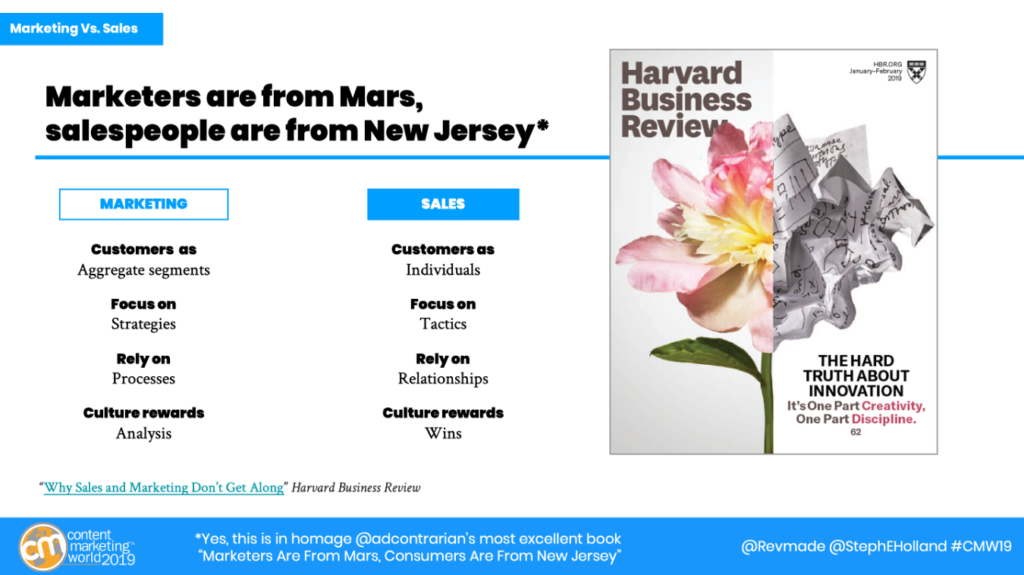How to drive better content marketing ROI by embracing the sales process
Want your content marketing to meet sales goals? Start by meeting with the sales team.A couple of years ago, I had the chance to present a session about marketing ROI to a room full of marketing and salespeople at an industry event. My co-presenter (Steph Holland, who leads an award-winning marketing and revenue generating sales team at C&EN for the American Chemical Society) and I joked that it was the first time sales had met with marketing in a long time. We got a lot of head nods, laughter and a few groans. And in an era where the Zoom call has replaced the staff all-hands meeting, the gap between these two groups has only grown.

While sales and marketing work for the same brand, drive growth for the same business and serve the same customer set, they rarely get together for a happy-hour drink – let alone an integrated planning session that puts the customer first and puts literal and figurative territories aside to develop a unified vision for how to work together to serving the community they sell to.
In other words, marketers are from Mars, and salespeople are from New Jersey.

One group tends to think in terms of campaigns, the other in terms of closing. Or, as Harvard Business Review puts it, “Marketing says, ‘We develop thoughtful strategies that can drive sales force success, but most salespeople won’t even take the time to understand them.’ Sales says, ‘Marketers are locked in the ivory tower. Their plans look good on paper but don’t work with real customers.’”
But the truth is, the most successful organizations find sales and marketing routinely teaming up to address the market with a cohesive message that is in lockstep up and down the funnel.
So how do we bridge the gap between how marketing and sales approach the market?
One great way to spark conversation about how these two entities can work better together at your organization is to determine where your brand needs the most firepower and focus. Then build marketing strategies at those moments that support sales in moving things forward with prospects.
Marketers deal in empathy. This approach is about being more empathetic toward what your sales team (in this diagram, represented by Sisyphus) is going through:

As marketers, one of our major reasons for being is to earn attention and relevance in pursuit of creating opportunities to earn ROI. In every market, this means understanding where your organization is struggling and creating campaigns and concepts that work through the friction. And no one feels this friction more than the sales organization.
After seeing this play out at organization after organization, we created this common sense framework for how marketers can better focus their content creation efforts around moments in the buying process:
Step 1: Earn permission. Your sales team needs permission to be in the room, and your brand needs permission to be on the radar of people looking for a solution. How can you do this?
Step 2: Demonstrate expertise. If the buyer knows about your business, that’s a good first step, but now you need to prove that you can solve their most pressing needs. Do you have the experience, the experts and the ability to get the job done? Yes! But buyers aren’t going to take your claims at face value; you’ll need to offer proof.
Step 3: Showcase social proof. Think about this as the before-and-after moment. Take an example customer and tell the story of where they were before they engaged with your business, and where they are now. Diet & weight loss marketers are excellent at doing this, but many other organizations cannot crisply articulate their value in a before/after setting.
Step 4: Survive the tire-kicking. In every mind and in every room where buying decisions are being discussed, the devil’s advocate has a way of raining on marketing’s parade. In just one doubt-provoking question (Yeah, but what about ____), the buyer’s journey can come to a complete standstill. Smart marketers, however, know that preemptively addressing all potential objections can help reduce friction at those moments and put the devil’s advocate on mute.
Step 5: Let your happiest customers do the talking. Whether you offer colonoscopies or IT solutions, potential customers are put most at ease when hearing about a successful experience from someone just like them. The problem? It can be awkward to ask a happy customer to sing your praises. So don’t ask them. Instead, find ways for them to participate by telling their story and being the star of it. (For example, Impexium’s Association Disruptors series focused on celebrating the customer’s success through a content campaign. Their brand took the backdrop.)
Mileage will vary, but we’re confident that this framework will get your marketing and sales teams off to a good start in the year to come.
In both sales and marketing, we like to think big. What’s the big idea that will change the perception of our brand in the marketplace? What’s the killer argument we can make to close the deal? The truth is, in both sales and marketing, there is no big yes. There are a thousand little yesses along the way. Content can set you up for a bunch of little yesses at the right moments to turn prospects into customers and then into advocates.
Whether it’s a matter of culture or a matter of practicality, marketing and sales work side-by-side but all-too-often with blinders on regarding what the other is doing. But taking those blinders off can get both entities closer to their goals. R
Subscribe
Get our weekly newsletter for tips on how to drive better content marketing performance.
For a regular stream of ideas, research and links we find helpful. And of course, to say hi!
